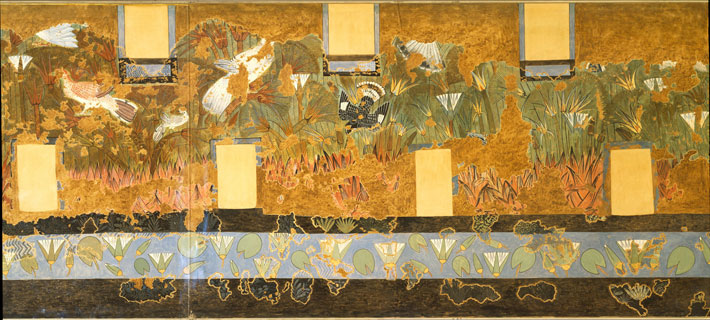 OXFORD, ENGLAND—According to a statement released by Antiquity, researchers Christopher Stimson and Barry Kemp of Oxford University have identified 12 bird species depicted in a naturalistic painting on plaster walls in a palace at the site of the ancient capital of Amarna. The palace belonged to Meritaten, a daughter of Nefertiti and the pharaoh Akhenaten, who ruled from about 1349 to 1336 B.C. The rare painting, discovered during a 1924 excavation, shows the birds in a wild papyrus marsh without any humans. An attempt to conserve it in 1926 caused some damage and discoloration, Stimpson explained. He and Kemp used a copy of the painting made in 1924, and compared what they saw with modern ornithological data to identify shrikes and wagtails, in addition to the kingfishers and pigeons identified by previous research. They also noticed that migrant birds are marked with a triangle, perhaps to indicate a season. Rock pigeons, which are not native to Egypt’s marshes, were also included in the painting. The researchers concluded that the pigeons may have been drawn to the area by human activity, just like modern pigeons. Alternatively, Stimson and Kemp think rock pigeons, which lived in desert cliffs, may have been included in the painting to make the image appear wild and untamed. Read the original scholarly article about this research in Antiquity. To read about an Amarna burial chamber that some believe was Nefertiti's tomb, go to "In Search of History's Greatest Rulers: Nefertiti, Great Royal Wife and Queen of Egypt."
OXFORD, ENGLAND—According to a statement released by Antiquity, researchers Christopher Stimson and Barry Kemp of Oxford University have identified 12 bird species depicted in a naturalistic painting on plaster walls in a palace at the site of the ancient capital of Amarna. The palace belonged to Meritaten, a daughter of Nefertiti and the pharaoh Akhenaten, who ruled from about 1349 to 1336 B.C. The rare painting, discovered during a 1924 excavation, shows the birds in a wild papyrus marsh without any humans. An attempt to conserve it in 1926 caused some damage and discoloration, Stimpson explained. He and Kemp used a copy of the painting made in 1924, and compared what they saw with modern ornithological data to identify shrikes and wagtails, in addition to the kingfishers and pigeons identified by previous research. They also noticed that migrant birds are marked with a triangle, perhaps to indicate a season. Rock pigeons, which are not native to Egypt’s marshes, were also included in the painting. The researchers concluded that the pigeons may have been drawn to the area by human activity, just like modern pigeons. Alternatively, Stimson and Kemp think rock pigeons, which lived in desert cliffs, may have been included in the painting to make the image appear wild and untamed. Read the original scholarly article about this research in Antiquity. To read about an Amarna burial chamber that some believe was Nefertiti's tomb, go to "In Search of History's Greatest Rulers: Nefertiti, Great Royal Wife and Queen of Egypt."
Egyptian Birds Identified in Ancient Palace Painting
